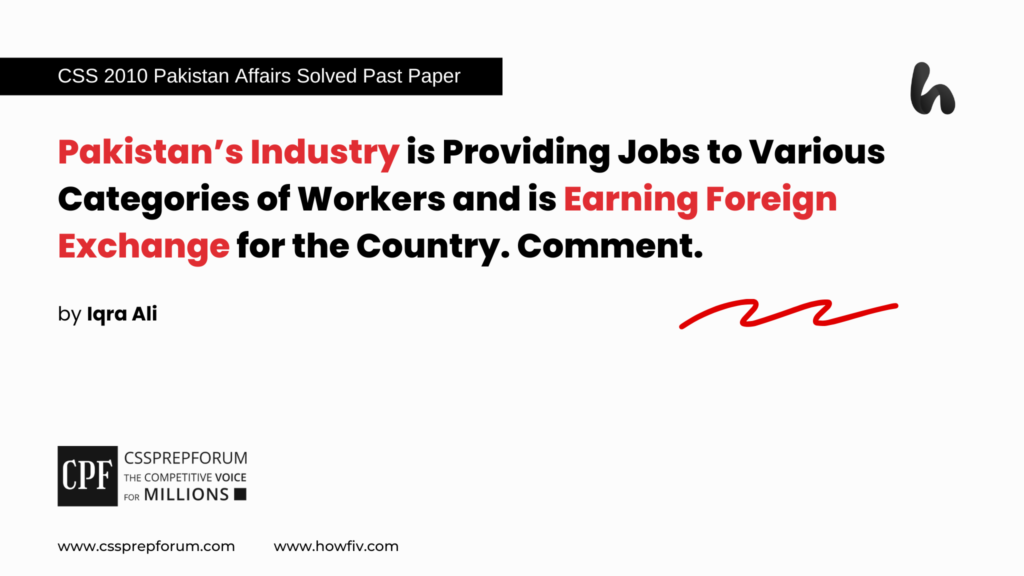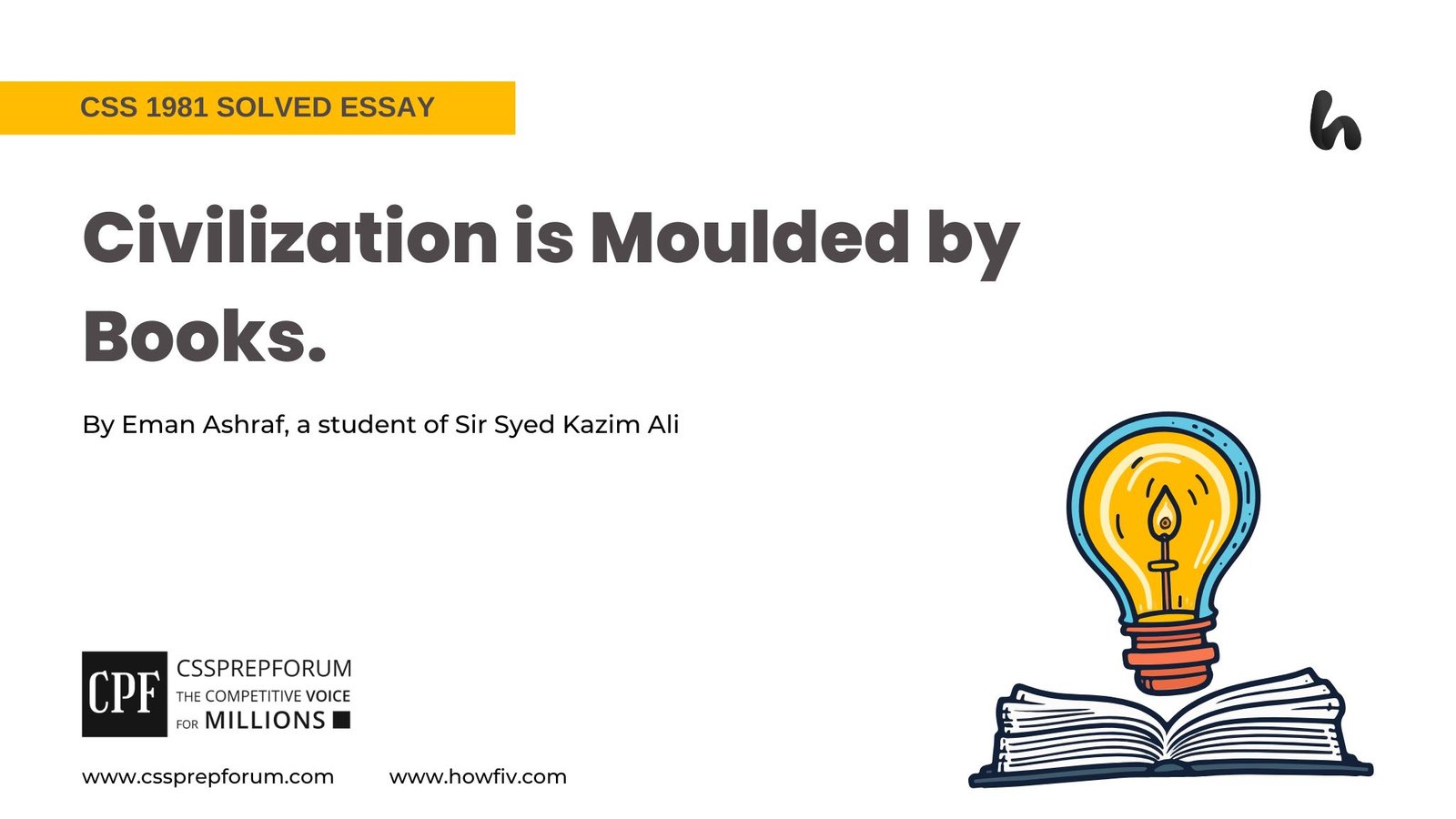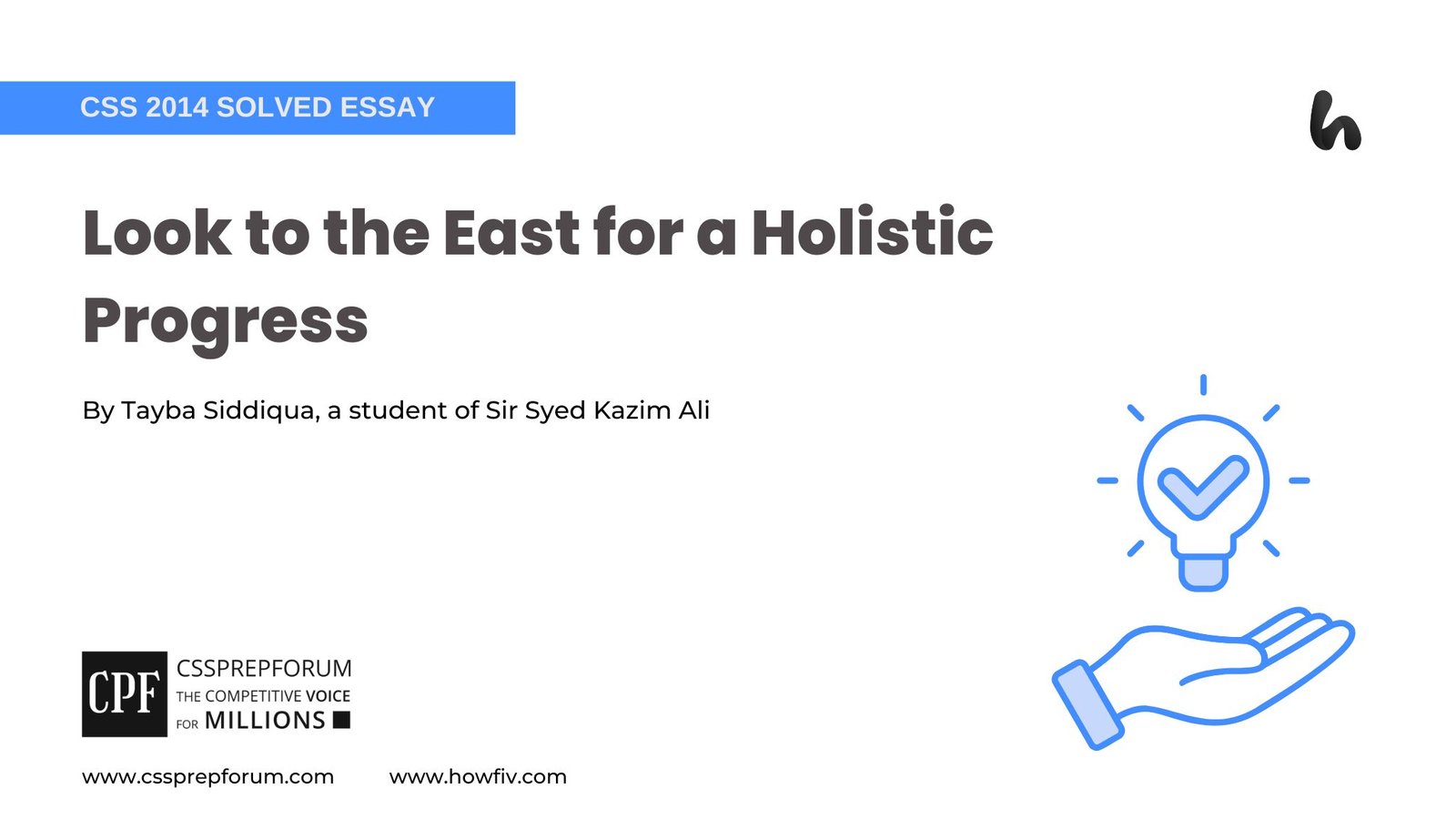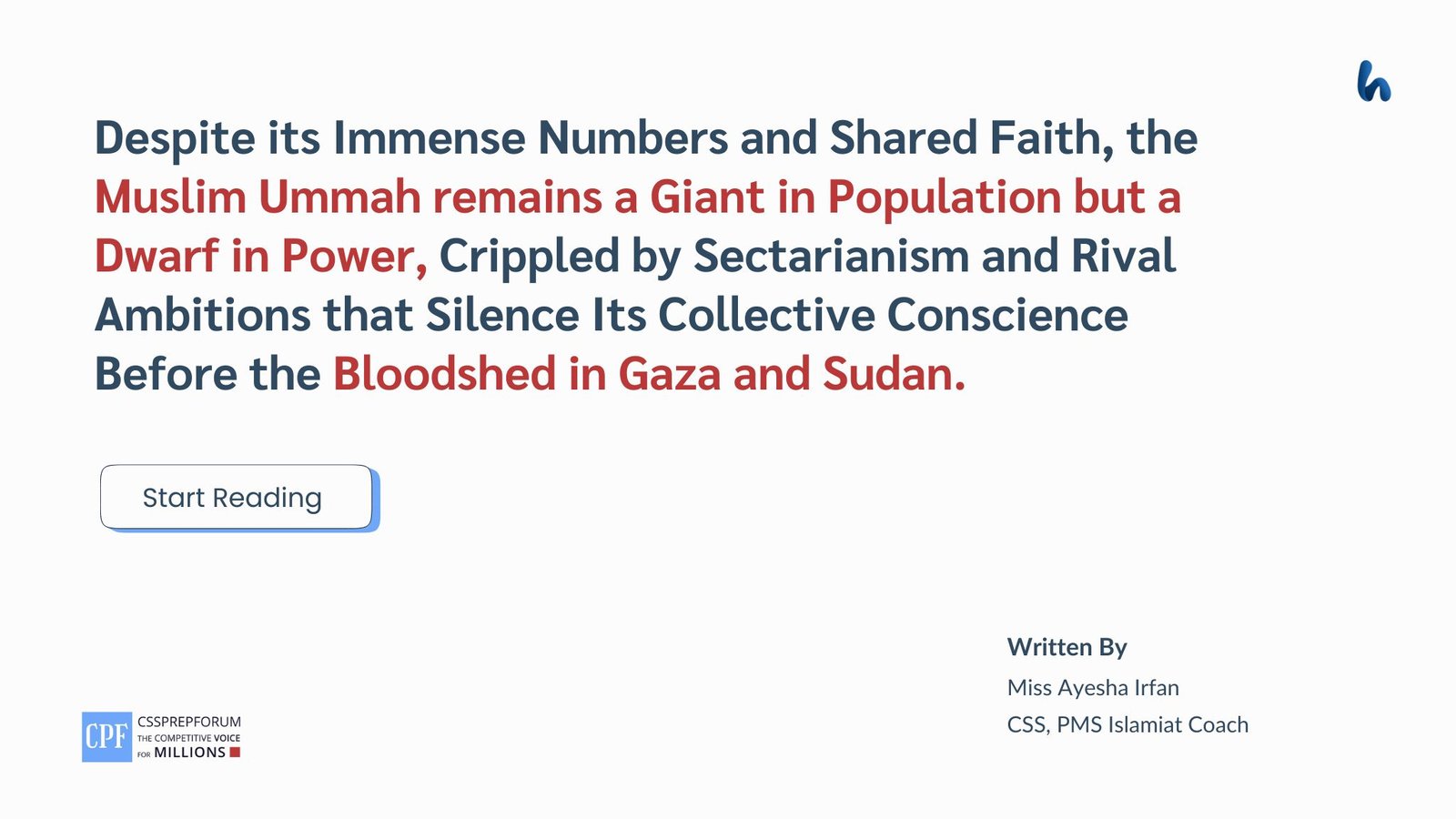CSS 2010 Solved Pakistan Affairs Past Papers | Pakistan’s Jobs Industry and Foreign Exchange
The following question of CSS Pakistan Affairs 2010 is solved by Miss Iqra Ali, the best Pakistan Affairs Coach, on the guided pattern of Sir Syed Kazim Ali, which he taught to his students, scoring the highest marks in compulsory subjects for years. This solved past paper question is uploaded to help aspirants understand how to crack a topic or question, how to write relevantly, what coherence is, and how to include and connect ideas, opinions, and suggestions to score the maximum.

Question Breakdown
In the question, the examiner has asked you to comment on two subjects; first, the categories of workers recruited in the industrial sector of Pakistan, and second, how the sector is earning foreign exchange for the country. You have to understand the purpose of the comment. Is it meant to analyze, critique, evaluate, or simply provide an opinion? If you find the purpose based on evaluation. Analyze the subject in detail. They discuss both the positive and negative aspects, supported by relevant examples. At last, conclude with a logical judgment or overall assessment.
Outline
1-Introduction
2-Historical Background of the Industrial Sector of Pakistan
3-Which Categories of Workers Does Pakistan’s Industry Employ?
- ✓Skilled Workers
- ✓Unskilled Workers and Semi-Skilled Workers
- ✓Women and Youth
- ✓Indirect Employment
4- How is the industry Earning Foreign Exchange for the Country?
5- Conclusion

Answer to the Question
Introduction
The industrial sector of Pakistan, among the agricultural and service industries, is one of the leading contributors to its economy. However, the country has a semi-industrialized economy, including textiles, chemicals, food processing, agriculture, and other industries. Historically, the country inherited a weak industrial base following the partition of the Subcontinent in 1947, and manufacturing accounted for about 17% of the Gross Domestic Product (GDP). According to Statista, the state’s Industrial sector made up 20.76% of the GDP in 2023, and in 2022, its share in providing nationwide employment was about 25.52%. The industrial sector employs diverse categories of the workforce, such as skilled, semi-skilled, women, and youth, in different sectors that include labour-intensive to technical work. Besides, the leading industries include the textile industry, vegetable ghee and cooking oil industry, sugar industry, fertilizer industry, cement industry, and chemical industry, and are earning foreign exchange for the country through exports. The export-oriented industries, such as textiles and apparel, sports, surgical instruments, and agro-based products, help generate capital. To sum up, the state ensures the inclusion of a diverse workforce in the economy that boasts productivity, encouraging exports to earn foreign currency. However, the sector faces several challenges due to narrow product options, the energy crisis, financial limitations, and less export-focused tendencies. Thus, a National Plan of Action (NAP) is indispensable to ensure diversification of products and export-led industry.
Historical Background of the Industrial Sector of Pakistan
The country inherited a weak industrial base following the partition of the Subcontinent. In 1947, manufacturing accounted for about 17% of Gross Domestic Product (GDP). The most significant industry was cotton, and cotton textile production contributed to industrial employment by about 19%. In 1999-2000, 60% of exports were of cotton yarn, textiles, cotton cloth, and knitwear. Other leading industries were vegetable oil, sugar, steel, tobacco, chemicals, and fertilizers. Further attempts were made on behalf of the government to diversify the industrial base that encourages exports. Small-scale and cottage industries were large in number, but they contributed only 6% of the Gross Domestic Product (GDP). In these industries, especially small-scale, the employment rate was also low. In 1999, the industrial sector saw an increase in its growth rate by 3.9%. The Industrial sector employed 17-18% of the working people since the 1980s. However, the employment rate was more centered in the manufacturing sector. The country’s manufacturing base has remained more contingent on textiles and sugar, which was vulnerable to global price changes and weather conditions. The liberalization efforts on behalf of the government since the early 1980s met with failure due to various challenges, such as corruption and raw material shortages. In the other way, the concessions on sectors to promote export burdensome the tax structure. As a result, the informal economy started to emerge.
Which Categories of Workers do Pakistan’s Industry Employ?
The country’s industrial sector employs diverse categories of workforce because of the economic slowdown, and the employment rate often decreases. The components of Pakistan’s industrial sector include mining and quarrying, fuel extraction industry, manufacturing, construction, and electricity, gas, and water supply. Statista reports illustrate that the country’s Industrial sector makes up 20.76% of the GDP in 2023. Coming to the point of the current status of the industrial sector in terms of employment rate. According to Statista, in 2022, the share of Pakistan’s industrial sector in providing nationwide employment was about 25.52%. The diversification in workforce engagement helps people to mitigate the issue of unemployment. The leading industries include the Textile Industry, Vegetable Ghee and Cooking Oil Industry, Sugar Industry, Fertilizer Industry, Cement Industry, and Chemical Industry. The following steps draw a sketch to understand the diverse categories of employment.
- ✓ Skilled Workers
First, the employment of skilled workers includes both professionals with degree holders and skilled laborers. Labour-intensive industries, especially manufacturing like textiles, garments, and handicrafts, require skilled labour for stitching, assembling, and packaging. Then, industries like pharmaceuticals, electronics, and automotive employ skilled forces with formal education in various roles, such as production, engineering, and design.
- ✓ Unskilled and Semi-Skilled Workers
Second, the employment of unskilled workers is more focused on assisting or labour roles in industries such as food processing and manufacturing. If unskilled workers have basic education, then employment criteria are different. For example, the aspirants or job seekers are trained for the role, such as an entry test helps educated students to enter the civil services or public administration after training. Similarly, related education to the field followed by training helps educated people get the job. For example, a bachelor’s in commerce helps people get a job in a bank after training sessions that enable them to develop the required skills for the job. In contrast, the unskilled with basic primary or secondary education are recruited in labor or assistance roles.
- ✓ Women and Youth
Third, women and Youth employment falls on the agenda of uplifting the marginalized sectors of society and encouraging young talent participation in economic activity. It helps them to earn capital that can assist them in financing for higher education or highly professional degrees. Besides, women are also recruited through indirect unemployment to promote workforce parity and inclusion of women in various fields of the economy.
- ✓Indirect Employment
Last, indirect employment in various industries in packing, logistics, and assembling helps the engagement of workers at different levels. The indirect employment in the economic zones helps various job seekers and students to manage finances through part-time jobs. It also helps women from different areas to earn capital. For example, in village-based schools, indirect employment recruits various women for assistance roles, such as office helpers for teachers and doctors.
How the Industry is Earning Foreign Exchange for the Country?
The industry is earning foreign exchange for the country through exports. The export-oriented industries, such as textiles and apparel, sports, surgical instruments, and agro-based products, help generate capital. According to the World Export Data, the country has shipped a total of US$28.7 billion worth of products around the world against the GDP of $338.37B in 2023. The following diagram shows country-specific exports from Pakistan. However, it’s out of 68.3% of products exported in 2023.
| Exported to | Percentage |
| United States of America | 17.4% of the Pakistani total |
| China | 9.5% |
| United Kingdom | 6.9% |
| Germany | 5.3% |
| Netherlands | 5% |
| Spain | 4.92% |
| United Arab Emirates | 4.88% |
| Italy | 4% |
| Afghanistan | 3.4% |
| Bangladesh | 2.4% |
| Saudi Arabia | 2.2% |
| Belgium | 2.36% |
The export products fall into two categories: first, products generating trade surplus, and second, products causing trade deficits for the country. The following diagram shows the leading exports of the country and their share in the total exports in 2023.
| Leading Products | Capital Generated | Percentage against Total Exports |
| Miscellaneous textiles, worn clothing | US$5 billion | 17.3% |
| Knit or crochet clothing, accessories | $4.2 billion | 14.5% |
| Clothing, accessories (not knit or crochet) | $3.3 billion | 11.6% |
| Cereals | $3.2 billion | 11.2% |
| Cotton | $3.1 billion | 10.6% |
| Copper | $772.2 million | 2.7% |
| Leather/animal gut articles | $632.1 million | 2.2% |
Conclusion
To conclude, the country has Diverse Workforce Engagement in the Industrial sector. It consists of Skilled Workers, Unskilled Workers and Semi-Skilled Workers, Women and Youth, and also utilizes Indirect Employment. The leading industries include the Textile Industry, Vegetable Ghee and Cooking Oil Industry, Sugar Industry, Fertilizer Industry, Cement Industry, and Chemical Industry. The following steps draw a sketch to understand the diverse categories of employment. Besides, the industry is earning foreign exchange for the country through exports. The export-oriented industries, such as textiles and apparel, sports, surgical instruments, and agro-based products, help generate capital.
CSS 2010 Solved Pakistan Affairs
| 2-Pakistan’s Industry is Providing Jobs to Various Categories of Workers and is Earning Foreign Exchange for the Country. Comment. | |
| 3- | |
| 4- | |
| 5- | |
| 6- | |
| 7- | |
| 8- |
CSS Solved Past Papers’ Essays
Looking for the last ten years of CSS and PMS Solved Essays and want to know how Sir Kazim’s students write and score the highest marks in the essays’ papers? Then, click on the CSS Solved Essays to start reading them.
CSS Solved Essays
CSS Solved General Science & Ability Past Papers
Want to read the last ten years’ General Science & Ability Solved Past Papers to learn how to attempt them and to score high? Let’s click on the link below to read them all freely. All past papers have been solved by Pakistan’s top CSS GSA coach having the highest score of their students.
General Science & Ability Solved Past Papers












